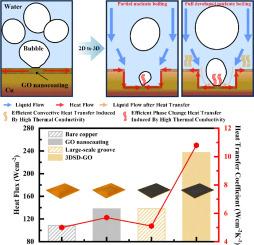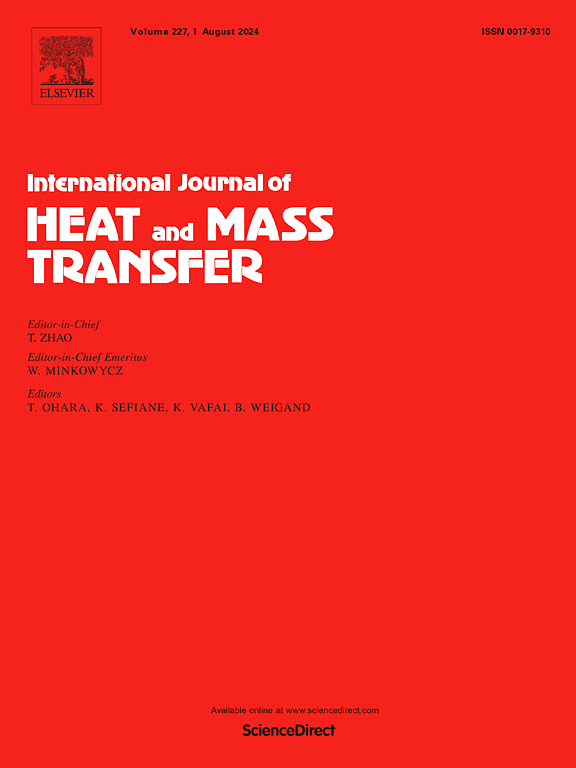基于飞秒激光的三维空间分布氧化石墨烯表面构建,用于增强沸腾传热
IF 5
2区 工程技术
Q1 ENGINEERING, MECHANICAL
International Journal of Heat and Mass Transfer
Pub Date : 2024-11-13
DOI:10.1016/j.ijheatmasstransfer.2024.126405
引用次数: 0
摘要
为了解决能源和超高散热应用中超高热流量传递的难题,池沸腾因其高热流量散热的优点而被广泛应用于各种极端传热领域。虽然石墨烯基平面纳米涂层具有优异的面内导热性,可用于提高池沸腾的传热性能,但由于纳米粗糙度和润湿性等可优化因素有限且难以控制,进一步提高沸腾特性仍具有挑战性。在这项工作中,利用飞秒激光预先设计和制造了具有三维微结构形貌的铜基板,以构建三维空间分布氧化石墨烯纳米涂层表面(3DSD-GO)作为一种新的热增强优化策略,从而获得新的传热增强因子。3DSD-GO 引入了自适应热传导-区域供液机制,可根据沸腾表面的热量分布自适应调整散热模式,实现对流传热和相变传热的协同增强。因此,3DSD-GO 可延迟临界热通量的触发时间,同时确保成核沸腾过程中传热系数的提高。此外,由于飞秒激光的灵活性,GO 纳米涂层可以形成各种不同形貌的微结构,从而获得不同的 3DSD-GO 以改善传热性能。总之,这项研究成果为突破石墨烯基纳米涂层的传热极限提供了重要启示,可应用于极端传热领域。本文章由计算机程序翻译,如有差异,请以英文原文为准。

Femtosecond laser-based construction of 3D spatially distributed graphene oxide surface for enhancing boiling heat transfer
To address the difficulties of ultrahigh heat flux transfer in energy and ultra-high heat dissipation applications, pool boiling has been utilized in various extreme heat transfer fields owing to the benefits of high heat flux dissipation. Although graphene-based planar nanocoating with superior in-plane thermal conductivity are employed to enhance heat transfer performance in pool boiling, further improvement of boiling characteristics remains challenging due to the limited and difficult-to-control optimizable factors, such as nanoroughness and wettability. In this work, utilizing a femtosecond laser, a copper substrate with a three-dimensional microstructure topography has been predesigned and fabricated to construct three-dimensional spatially distributed graphene oxide nanocoating surface (3DSD-GO) as a new heat enhancement-optimization strategy in order to obtain a new heat transfer enhancement factor. 3DSD-GO introduces adaptive heat conduction–regional liquid supply mechanism that can adaptively adjust the heat dissipation mode according to the heat distribution of boiling surface to achieve the synergy enhancement of convective heat transfer and phase-change heat transfer. Therefore, 3DSD-GO delays the trigger of the critical heat flux while ensuring the improvement of heat transfer coefficient during nucleate boiling. Additionality, owing to the flexibility of femtosecond laser, GO nanocoating can be formed at a variety of microstructures having different topography and obtain different 3DSD-GO to improve heat transfer performance. Overall, the findings in this work provide a remarkable insight toward breaking the heat transfer limit of graphene-based nanocoating and can be applied in extreme heat transfer fields.
求助全文
通过发布文献求助,成功后即可免费获取论文全文。
去求助
来源期刊
CiteScore
10.30
自引率
13.50%
发文量
1319
审稿时长
41 days
期刊介绍:
International Journal of Heat and Mass Transfer is the vehicle for the exchange of basic ideas in heat and mass transfer between research workers and engineers throughout the world. It focuses on both analytical and experimental research, with an emphasis on contributions which increase the basic understanding of transfer processes and their application to engineering problems.
Topics include:
-New methods of measuring and/or correlating transport-property data
-Energy engineering
-Environmental applications of heat and/or mass transfer

 求助内容:
求助内容: 应助结果提醒方式:
应助结果提醒方式:


